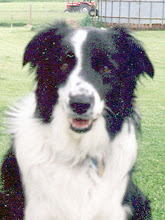The trial field at Edgeworth.
I can fill pages with everything I learned at the Virginia Triple Crown Sheepdog Trials. (But, because this is a blog--I'll refrain, sort of, I promise).
Over the course of nine days, Bubba ran six times on three different fields with three different types of sheep. Emma ran five times.
My main goal was to continue forming a partnership with Bubba. He arrived at the farm in late May, fully trained. But he has a different style than my previous dogs--and I have a different style than his previous handler. We aren't yet a solid team (though we made big leaps over the past few weeks).
I also wanted to get more experience on working on big fields with different types of sheep.
So here's a little about what we learned:
1. A dog that finds sheep at 600 yards away is an amazing thing.
I have never sent a dog 600 yards to find sheep, and I stood at the post, whistle at the ready, watching and hoping. The dogs took off, looking and casting out, running over hills and out of sight a few times, and I had to trust they were on the right path. They were.
2. Both of my dogs did poorly at flanking on the fetch (until they got closer to me).
That means I'm going to have to practice flanking on the fetch, walking out to correct them, and to keep increasing my distance. It'll be a good winter project.
3. Eleven minutes is a really long time.
Over the past few years, I've really worked on focusing and observing what my dog and the sheep are doing on the field (instead of what I hope they are doing). As the dog is working, I'm watching and asking: When I give a flank whistle, does my dog take it? Does he slice his flank? How are the sheep responding? Where is the line? This still doesn't come naturally to me. Thus, 11 minutes is a really long time. (Most courses I run are in the 8-minute range).
4. Even at a sheepdog trial, you can phone a friend.
With Bubba, I've been working on whistle cues, flanks, timing and shedding, but not so much on penning. After two failed attempts at the pen, I called his previous handler and trainer. "He's a big dog," she said. If he sliced a flank, even a little bit, it would be enough to unsettle the sheep. "Tell him to get out before you flank him," she said. I tried it at the next trial. It wasn't smooth, nor pretty. But it helped and we penned the sheep.
5. Working four lambs is really hard.
I have lambs at home. I know how unpredictable they can be, especially when they don't have an older ewe as a leader. Working four lambs that were in a new environment and that hadn't been worked in small groups was really challenging. Sometimes they wanted to look at the dog. Sometimes they wanted to run. Sometimes they did a little of both.
6. You can retire, and still be impressed with your dog
Sheep behave differently depending on who is in their group, the dog, the weather and the time of day. At one trial, I ran during a difficult afternoon stretch when the sheep seemed to be winning. They kept running back to the set out pens, and there were more disqualifications and retires than scores on the board. When I sent Emma to get the sheep, she found them, but then a wily ewe got past her and bolted down a hill and out of sight. I could not see what was going on. After scanning the hilltop for what seemed like minutes, I retired and began the 400 yards up the field to find my dog. That's when I heard, "She's got the sheep" being relayed from the set-out person. Several seconds later, the sheep appeared on the hilltop, and Emma was bringing them to me--and handlers were applauding her efforts. She won.
7. At a trial, my whistles sound like a banshee--and Bubba doesn't speak that language.
My trial whistles sound nothing like my practice whistles. Thank you adrenaline. My other dogs have put up with it. Bubba does not. To him, it sounds like I'm yelling at him. Don't let his size fool you. He's a big marshmallow. Halfway through my third run, I realized what was happening and softened my whistles. The improvement was dramatic. Bubba is going to train me to soften my whistles, and that's a good thing.
8. Bubba is also going to teach me to watch for and correct sliced flanks.
Bubba is a big dog and a little slice has a big impact on the sheep. When I saw it and corrected for it, the drive got better.
9. Not all sheep are the same.
Katahdin sheep were used in all three trials--and all behaved differently. At the first trial, we worked four Katahdin lambs that were unpredictable and tricky and not used to being worked by dogs. At the second, we worked two lambs and a ewe that were seldom worked by dogs. While the lambs had a leader, the lead ewe often acted like she had no friends and would split from the lambs. Both of these combinations required a dog that could push the sheep along. At the third trial, we worked three ewes who were used to being worked by dogs. I made the mistake of not stopping Bubba when he reached his sheep and putting the brakes on him. It made for a lively run and a lesson learned.
10. My dogs amaze me.
No, I'm not bragging. I just am amazed at how hard they work and how hard they try to be right and how willing they are to work with me and to put up with my blunders.













